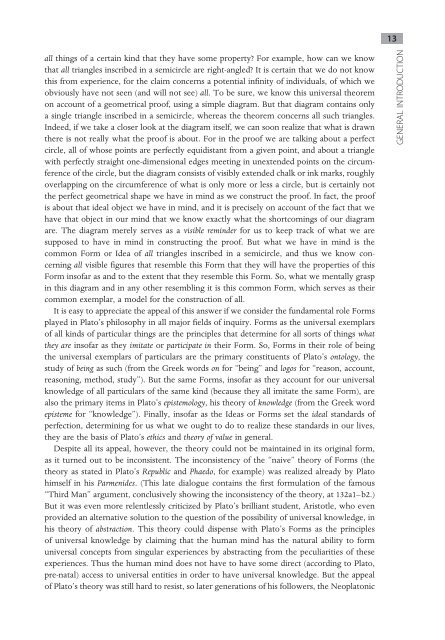Blackwell Readings in Medieval Philosophy - Fordham University ...
Blackwell Readings in Medieval Philosophy - Fordham University ...
Blackwell Readings in Medieval Philosophy - Fordham University ...
Create successful ePaper yourself
Turn your PDF publications into a flip-book with our unique Google optimized e-Paper software.
MP_A02.qxd 11/17/06 5:26 PM Page 13<br />
all th<strong>in</strong>gs of a certa<strong>in</strong> k<strong>in</strong>d that they have some property? For example, how can we know<br />
that all triangles <strong>in</strong>scribed <strong>in</strong> a semicircle are right-angled? It is certa<strong>in</strong> that we do not know<br />
this from experience, for the claim concerns a potential <strong>in</strong>f<strong>in</strong>ity of <strong>in</strong>dividuals, of which we<br />
obviously have not seen (and will not see) all. To be sure, we know this universal theorem<br />
on account of a geometrical proof, us<strong>in</strong>g a simple diagram. But that diagram conta<strong>in</strong>s only<br />
a s<strong>in</strong>gle triangle <strong>in</strong>scribed <strong>in</strong> a semicircle, whereas the theorem concerns all such triangles.<br />
Indeed, if we take a closer look at the diagram itself, we can soon realize that what is drawn<br />
there is not really what the proof is about. For <strong>in</strong> the proof we are talk<strong>in</strong>g about a perfect<br />
circle, all of whose po<strong>in</strong>ts are perfectly equidistant from a given po<strong>in</strong>t, and about a triangle<br />
with perfectly straight one-dimensional edges meet<strong>in</strong>g <strong>in</strong> unextended po<strong>in</strong>ts on the circumference<br />
of the circle, but the diagram consists of visibly extended chalk or <strong>in</strong>k marks, roughly<br />
overlapp<strong>in</strong>g on the circumference of what is only more or less a circle, but is certa<strong>in</strong>ly not<br />
the perfect geometrical shape we have <strong>in</strong> m<strong>in</strong>d as we construct the proof. In fact, the proof<br />
is about that ideal object we have <strong>in</strong> m<strong>in</strong>d, and it is precisely on account of the fact that we<br />
have that object <strong>in</strong> our m<strong>in</strong>d that we know exactly what the shortcom<strong>in</strong>gs of our diagram<br />
are. The diagram merely serves as a visible rem<strong>in</strong>der for us to keep track of what we are<br />
supposed to have <strong>in</strong> m<strong>in</strong>d <strong>in</strong> construct<strong>in</strong>g the proof. But what we have <strong>in</strong> m<strong>in</strong>d is the<br />
common Form or Idea of all triangles <strong>in</strong>scribed <strong>in</strong> a semicircle, and thus we know concern<strong>in</strong>g<br />
all visible figures that resemble this Form that they will have the properties of this<br />
Form <strong>in</strong>sofar as and to the extent that they resemble this Form. So, what we mentally grasp<br />
<strong>in</strong> this diagram and <strong>in</strong> any other resembl<strong>in</strong>g it is this common Form, which serves as their<br />
common exemplar, a model for the construction of all.<br />
It is easy to appreciate the appeal of this answer if we consider the fundamental role Forms<br />
played <strong>in</strong> Plato’s philosophy <strong>in</strong> all major fields of <strong>in</strong>quiry. Forms as the universal exemplars<br />
of all k<strong>in</strong>ds of particular th<strong>in</strong>gs are the pr<strong>in</strong>ciples that determ<strong>in</strong>e for all sorts of th<strong>in</strong>gs what<br />
they are <strong>in</strong>sofar as they imitate or participate <strong>in</strong> their Form. So, Forms <strong>in</strong> their role of be<strong>in</strong>g<br />
the universal exemplars of particulars are the primary constituents of Plato’s ontology, the<br />
study of be<strong>in</strong>g as such (from the Greek words on for “be<strong>in</strong>g” and logos for “reason, account,<br />
reason<strong>in</strong>g, method, study”). But the same Forms, <strong>in</strong>sofar as they account for our universal<br />
knowledge of all particulars of the same k<strong>in</strong>d (because they all imitate the same Form), are<br />
also the primary items <strong>in</strong> Plato’s epistemology, his theory of knowledge (from the Greek word<br />
episteme for “knowledge”). F<strong>in</strong>ally, <strong>in</strong>sofar as the Ideas or Forms set the ideal standards of<br />
perfection, determ<strong>in</strong><strong>in</strong>g for us what we ought to do to realize these standards <strong>in</strong> our lives,<br />
they are the basis of Plato’s ethics and theory of value <strong>in</strong> general.<br />
Despite all its appeal, however, the theory could not be ma<strong>in</strong>ta<strong>in</strong>ed <strong>in</strong> its orig<strong>in</strong>al form,<br />
as it turned out to be <strong>in</strong>consistent. The <strong>in</strong>consistency of the “naive” theory of Forms (the<br />
theory as stated <strong>in</strong> Plato’s Republic and Phaedo, for example) was realized already by Plato<br />
himself <strong>in</strong> his Parmenides. (This late dialogue conta<strong>in</strong>s the first formulation of the famous<br />
“Third Man” argument, conclusively show<strong>in</strong>g the <strong>in</strong>consistency of the theory, at 132a1–b2.)<br />
But it was even more relentlessly criticized by Plato’s brilliant student, Aristotle, who even<br />
provided an alternative solution to the question of the possibility of universal knowledge, <strong>in</strong><br />
his theory of abstraction. This theory could dispense with Plato’s Forms as the pr<strong>in</strong>ciples<br />
of universal knowledge by claim<strong>in</strong>g that the human m<strong>in</strong>d has the natural ability to form<br />
universal concepts from s<strong>in</strong>gular experiences by abstract<strong>in</strong>g from the peculiarities of these<br />
experiences. Thus the human m<strong>in</strong>d does not have to have some direct (accord<strong>in</strong>g to Plato,<br />
pre-natal) access to universal entities <strong>in</strong> order to have universal knowledge. But the appeal<br />
of Plato’s theory was still hard to resist, so later generations of his followers, the Neoplatonic<br />
13<br />
GENERAL INTRODUCTION

















